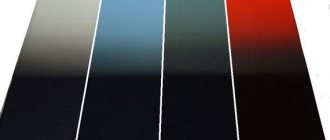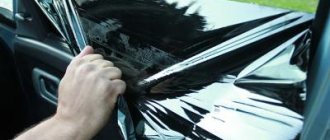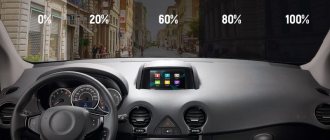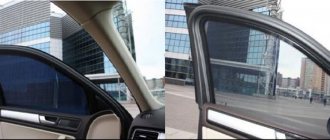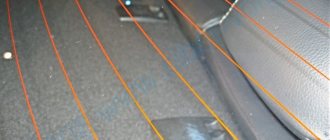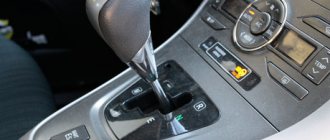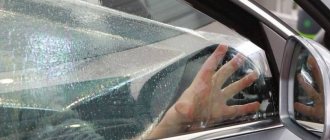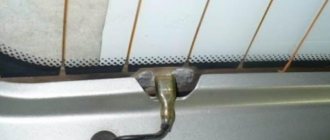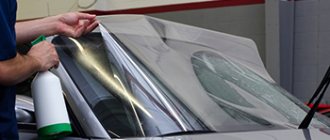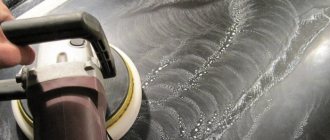How to properly tint windows
Good visibility of the road will ensure an adequate assessment of the traffic situation and timely action in emergency cases. Therefore, the light transmittance of glass is a category of passive safety of a car. It prevents road accidents.
The required visibility parameters for the front, side and rear glazing of the car were established experimentally and established by standards. When applying tinting, you must follow the standards of GOST 32565 2013 . In accordance with clause 5.1.2.5. The light transmission standards are:
- for windshields (front) windows - from 70%. Until 2016, the requirements were stricter - the loss of light transmission should not exceed 25%;
- to the windshield . According to the standard, its width is limited to 14 cm from the top edge;
- for front side windows , as well as other non-frontal glazing that affects the view of the road in front and behind - at least 70%;
- The light transmission of the rear windows is not standardized, but only when installing a pair of side rear-view mirrors.
It turns out that a car that has lost one of its external mirrors may well be stopped by a traffic police inspector to check the visibility and visibility on the driver’s side. But what then should be the result of the check in order not to run into a fine?
Everything is determined by GOST. At least 70%: same as for non-windshields. However, in practice, the windshield and front door glass are checked.
Automotive repair shops must adhere to these standards when applying glass film. These are the indications that should be used by traffic police during roadside checks.
The settlement of tinting issues was not without controversy. The document has been in use for almost two years: in 2015 it replaced standard 5727-88. However, in most cases, traffic cops are guided by outdated standards, since the List of faults and conditions under which the operation of a vehicle is prohibited specifies GOST 5727 88 (clause 7). And this is already a reason to challenge the fine for incorrect tinting, if the protocol was drawn up for light transmittance of 75 - 70%.
What to consider when tinting
There are points that will have to be taken into account when styling:
- mirror tinting is absolutely prohibited;
- In addition to maintaining the visibility of the glass, the driver’s color perception should not be distorted. And even without film tricks it worsens in the dark;
- Even new glass does not initially transmit light completely: up to 90-95%. Road dust will further reduce visibility by 5-10%. If “worn-out” glass is installed, then its ability to transmit visible rays is reduced by about 20%. Therefore, even a film that meets the requirements of GOST can fail when meeting an inspector on the road;
- Cars of some foreign brands are already coming off the assembly line with tinted windows. Additional devices will definitely lead to non-compliance with standards.
When a car is purchased second hand, before applying light protection, you should measure how much light the windshield, side and rear windows initially transmit in daytime conditions, as well as at dusk. For a new car, the data can be found in the owner's manual.
Types of tinting based on film material
In addition to application methods, the various materials from which the film is made are also distinguished. Based on this parameter, you can create an unusual color effect on the glass, reduce the heating of the car interior, and much more.
The film can be:
Metallized
This type can significantly reduce interior heating. The film itself is a thin aluminum coating that can reflect the sun's rays. Aluminum creates a stylish metallic shine.
However, such a film has one significant drawback - it does not transmit signals, so the mobile phone in the car will work intermittently.
Infinity
This type is also known as mirror tinting. By and large, this material resembles metallic, with some differences. In this case, the aluminum coating is located on the outside, and not between layers of colored thin material. Because of this, “infinity” is characterized by increased strength and better protection from sunlight.
The advantages of this film also include good interior darkening, which does not impair visibility when performing maneuvers. Among the disadvantages, it is worth noting the high cost and the formation of glare outside at night.
Athermal film and “chameleon”
Athermal tinting of the windshield involves the application of a special material that can reflect the main part of the rays of the solar spectrum. Thanks to this, the car interior also does not overheat under the influence of the sun. The main feature of this film is that the glass remains completely transparent.
Chameleon windshield tinting is a type of athermal tinting. The peculiarity of this material is that it changes color at different viewing angles. The result is a very unusual and stylish effect, while the glass is almost completely protected from infrared and UV radiation.
Carbon
This type of film is considered the most high-tech at the moment. Its material is a micro-thin graphite layer sprayed in a vacuum. Thanks to this, carbon film has the following advantages and useful characteristics:
- reflects the sun's rays no worse than metalized analogues;
- does not block cellular signal;
- resistant to fading and UV radiation;
- has the longest (compared to analogues) service life.
The only downside that can be highlighted is that there are not many car services involved in installing such tinting and they are all located in large cities.
How to determine the light transmission of film
You can find out this parameter by the marking of the film. The number on the packaging gives an accurate indicator of possible visibility. Let's see how standard films affect the final result:
| Film transmittance (%) | Visibility of the interior from the street | Visibility of the road to the driver during the day in ideal conditions | Visibility of the road at night in favorable weather |
| 5 | completely absent | satisfactorily | very bad |
| 15 | silhouettes are visible | satisfactorily | Badly |
| 20 | faces are visible | Fine | Satisfactory, but difficult to maneuver |
| 35 | the interior is visible, but the details are blurry | Fine | satisfactorily |
| 50 | everything is visible in detail | excellent | good |
Scheme of blind tinting “in a circle”«:
- rear (including door windows) - 5%;
- side front doors - 15%;
- windshield - 35%.
In practice, the part of the cabin behind the front seats is completely invisible. If you look closely, you can see the outlines of those sitting in front. There is no need to talk about compliance with standards with such a scheme.
Partial tinting scheme:
- rear windows - 15%;
- front doors - 15%;
- windshield is not processed.
The driver is provided with satisfactory visibility of the road in front of the car, visibility of the side areas and behind the vehicle is reduced. on the windows The requirements are violated on the windows of the front doors.
Rear semicircle pattern:
- the “forehead” and front side windows remain clean;
- The rear door glazing is covered with a film with any light tolerance rating.
This option practically corresponds to GOST.
Video: Tinting car windows according to GOST requirements. What tint is acceptable?
A selection for you!
Download forms and sample documents for motorists to a safe place.
Types of films
Car window tinting can be done using the following types of films:
- athermal. A special feature of the model is the absolute invisibility of the layer; it is used exclusively as a protective coating. The benefits of applying athermal film come down to protection from the scorching rays of the sun, preserving the appearance for a long time without affecting it in any way, which is appreciated by lovers of classic designs. Traffic police officers will not be able to make claims against the glass. The product is supplied in rolls with a multi-layer and fairly dense coating, which effectively protects against damage;
- with metal particles - it is called mirror. This type of glass tinting will create a mirror-like appearance when viewed from the outside. The range includes options with varying degrees of mirroring and color saturation. There are not only silver films, you can choose black or dark colors. The disadvantage is possible problems with the traffic police;
- painted. Helps to add or complement the style of the car. With its help you can create a holistic appearance and perception of the design. There are many degrees of darkening; when choosing, you need to study the assortment in the city stores. It can be pasted over manually;
- art or with a picture. This tint is always translucent, and some image is printed on it. Perfect for self-expression at low financial cost. Most often, drawings are placed on the doors, but there are also options for the rear window. Almost never sticks to the front;
- perforated. This type of toning is actively used for advertising media. It is often applied to most of the surface of the car. Saturation, color density, hue, pattern and all other parameters are selected individually. Most often it has to be ordered. A distinctive feature is the presence of small holes; they provide sufficient light conductivity;
- silicone. Can be applied and removed at will. Electrostatic effect is used for fastening; no glue is needed;
- color tinting. The only difference is the variety of colors.
In each film, the manufacturer strives to achieve the same technical characteristics: protecting the interior from ultraviolet radiation and preventing glass destruction from mechanical damage. If desired, you can easily dismantle the covering and install another one. The exception is factory tint, which cannot be removed.
Athermal tinting
Factory tint
The well-known desire to darken windows has been taken into account by car manufacturers; some of them immediately install darkened windows. The car will be tinted at the factory upon a separate request; the entire line is not subject to tinting due to various wishes of customers.
The main disadvantage is the non-removable type of construction, but the advantage is that it cannot be scratched, that is, it is an eternal tint that is not subject to fading, wiping, etc. It is impossible to create such a coating with your own hands.
The technology is characterized by the application of a special finely dispersed paint that is resistant to various negative influences. No film is used. Similar work can be performed in a service station, but the quality will still be somewhat lower, since homemade technologies are unable to completely repeat this process.
Electronic tinting
A new direction in tinting is smart, the coating has an interactive reflection. If desired, the driver can change the saturation and even the color of the material. It is based on the principle of the influence of electric current on a special substance, the particles of which, changing their orientation, change the degree of transparency of the inner layer of the film. A small remote control is used for control; it is included in the kit.
Electronic car window tinting
The advantages are obvious:
- You can express yourself in new ways every day;
- there is no need to re-stick the film to change color;
- When approaching a traffic police post, it is easy to increase the transparency of the glass to avoid a fine, and the rest of the time, increase the level of darkness.
The main disadvantage is the high price. The cost of smart glass ranges from $5 to $10 thousand.
Do newfangled items meet the standards?
Athermal tinting . This type of treatment has received recognition from car enthusiasts due to its complete transparency combined with the noble shade of the glass. It's visual. Technical parameters are much more important:
- the light transmittance of the “athermal” initially complies with GOST 32565: depending on the manufacturer, from 75 to 82;
- while ensuring excellent visibility, tinting protects against ultraviolet and infrared radiation in parameters around 90%. Even in sweltering heat, the car will be comfortable, the upholstery will not fade;
- at night, it reduces the glare of oncoming headlights by 25% and generally protects the driver’s eyes from fatigue;
- will protect the driver and passengers from injury in accidents: glass fragments will remain on the film itself and will not scatter throughout the cabin
When gluing athermal film onto protonated factory glass or onto an old base, the percentage of light transmission decreases.
Available in several shades: bottle green, yellowish green, sky blue. The latter option may cause slight glare.
Chameleon . Essentially this is a type of athermalok. The property of effectively changing shades depending on the illumination and the angle of incidence of the light beam makes the new product stand out from the general range. Help in case of an accident? The chameleon line offers premium protection with a light tolerance of 93%. Which guarantees GOST standards when applied to any base. The remaining parameters are similar.
Types of tint films
All types of tinting coatings are usually classified into three categories:
- decorative;
- impact resistant;
- sun protection
Types of tinting according to technology
Considering the technological process, tinting can be as follows:
- Removable is most in demand due to its ease of implementation. There is no need for outside help or additional financial costs.
- Electronic coating is one of the most expensive. This option is not for the middle class, since a square meter of tinted glass will cost one and a half thousand dollars. The essence is the ability to adjust the light transmittance of the coating depending on the wishes of the driver and the time of day. There are two options: connecting a special film to the electrical wiring or using smart glass, which completely replaces the factory glass.
- Spray tinting can only be carried out to a truly high quality by employees of auto repair shops. Due to the need to lower the glass into a vacuum chamber, it is impossible to implement this procedure at home. Glare and cracks on such a coating appear quickly, the technology itself is labor-intensive, and the coating cannot be removed in the future - all this has become the reason for the unpopularity of this option.
This is interesting: Land Cruiser 200: ground clearance, weight, length
Categories of light filter films
Considering the characteristics of the material, it is worth highlighting the following categories of light-filtering coatings:
- Dyed film for tinting car windows is one of the most budget-friendly options. This coating does not create glare and does not block radio waves; it is created by introducing a coloring pigment into the polymer structure. Mechanical protection is presented in this case at a weak level, therefore, one cannot count on a long service life of the color film.
- The spatter film is produced by ionization, which makes the metallic effect as uniform as possible. Lifetime warranty.
- Metallized ones are produced by sputtering aluminum onto the painted layer between the protection and the toner. Advantages include resistance to external factors, resistance to fading and UV protection.
- Materials with a shadow transition involve spraying technology from bottom to top in an increasing manner, the so-called gradient. The upper section of the glass provides maximum sun protection.
- Infinity involves placing the metal coating not between the layers, but on the outside, therefore, ultraviolet radiation is blocked more effectively, and the coating itself exhibits a mirror effect. This option is prohibited by law.
- Athermal film on the windshield prevents glare and reduces strain on the visual organs. It belongs to the category of innovative materials, since the transparency of glass remains almost at the same level.
- Carbon coating is a graphite layer that is applied over the glass and effectively blocks ultraviolet radiation.
Responsibility for deviations from standards
Well, there’s so much you can’t read on the Internet. And 5 thousand, and one and a half. Sometimes they write about a “progressive” system of fines for repeated detections of incorrect tinting. However, this information is not true. As of December 2021, administrative responsibility in this part is insignificant:
- The punishment is provided for in Part 31 of Art. 12.5 of the Code of Administrative Offenses of the Russian Federation and amounts to 500 rubles . No options or warnings;
- Any State Traffic Inspectorate employee with a special rank has the right to draw up a protocol and issue a fine at the scene of the accident;
- no additional security measures (removal of license plates or detention of the vehicle) are applied.
But if the driver does not pay the fine within 70 days from the date of entry into force of the AR, he will be held accountable under Art. 20.25 p.1. This is where the fine can be doubled and more. According to the decision of the court that considers such cases, you can be sentenced to 15 days or receive up to 50 hours of compulsory work.
Failure to pay fines within the legal period is an independent type of offense. The same punishment threatens other fines for “delays”. Even if the driver has been punished under 20.25, the obligation to “settle” for the first accident is not removed from him.
You can also hire a car repair shop
Federal Law 196 “On Road Safety” considers entrepreneurs involved in the operation of transport responsible for what is happening on the roads.
Legal entities and private entrepreneurs are obliged to ensure full compliance of the technical condition of the vehicle with regulatory road safety requirements. As a result of their activities, vehicles with faulty components or dangerous technical features should not be allowed on the roads.
So the owners of organizations that provide tinting services with deviations from the standard are subject to administrative liability.
- The traffic police sends a request to the enterprise to eliminate the causes and conditions leading to the offense. In legal language this is called a writ;
- The company's management is obliged to send a written response on the measures taken within the period established by law;
- if no “movement” follows, the activity of the auto repair shop or individual entrepreneur is suspended with the holding of those responsible to administrative liability for failure to comply with the order.
Depending on the organizational and legal form of the work producer, the protocol is drawn up for a legal entity or an individual entrepreneur. Fines are established by Part 1 of Art. 19.5 Code of Administrative Offenses of the Russian Federation :
- for citizens (individual entrepreneurs, mechanics, etc.) - 300-500 rubles;
- for officials - 1-2 thousand or disqualification for up to 3 years;
- for legal entities 10-20 thousand.
Become more invisible or is there a GOST after tinting?
The final light transmittance can be calculated by multiplying the initial indicators of glass and film. Let’s say a car repair shop applied a regular 50% film to good glass. We get 0.9 x 0.50 = 0.45.
Thus, applying standard films to the front “semicircle” will definitely make us violators. This is confirmed by traffic police officers.
But if you choose a high-quality thermal film, then the chances of not disturbing it are much greater.
Tinting is a special darkening coating on car windows designed to minimize the entry of light rays and visibility of the car interior.
Thanks to the tinting coating, it will be possible to reduce the light absorption of the glass, and this prevents heating of the interior.
However, excessively tinted vehicle windows directly contradict established laws of the Government of the Russian Federation, which will entail the imposition of a fine.
The law, which changed the standards for the use of tinting coatings for automobile windows, has already been in force in the country since January 1, 2017.
What is the essence of tightening glass tinting rules? What tinting is allowed according to GOST in 2021 and how will this affect ordinary motorists?
Glass tinting standards
The main innovation of this law is the change to GOST, which regulates the level of light transmission of tinted car glass.
The new GOST involves dividing all car glass into 2 categories:
- Category No. 1 - glass that provides the driver with front visibility;
- Category No. 2 - glass that provides the driver with rear visibility.
What percentage of tint is allowed? Permitted tinting of front windows (first category) according to GOST is determined by the following light transmittance coefficients:
- windshield tinting according to GOST - 75%;
- tinting on the side front windows - 70%;
- According to GOST, tinting the rear windows of a car is not limited only if the car is equipped with side mirrors on both sides for rear view;
- In the upper area of the windshield, tinting of any light transmittance is permitted, but the width of the tinting coating is limited to 140 mm.
It is worth noting that traffic regulations permit the use of curtains for buses, window blinds and blinds for the rear windows of a passenger car, which is equipped with two rear-view mirrors on both sides.
So, the new standard allows you to curtain or tint the rear window of a car with any type of tint.
Video: Tinting car windows. What tint is acceptable?
Nuances of choice: how to cover the rear and front windows of a car
Having decided on your attitude to GOST and its standards, you can proceed directly to choosing an option for yourself. Please note that the glass itself does not transmit 100% of the light (usually 90-95%). Before installation, it is advisable to take a small piece of material and check the total light penetration rate with the device.
Let's start with the "state employees". If finances are very limited, then you can even look towards Chinese film. Just don’t glue it yourself - you’ll suffer, use the services of pasters (you can then demand that the defects be eliminated from them). If you are consciously prepared for a short service life and gradual loss of color, this may be your option.
Dyed films from “famous” manufacturers from the previous section are distinguished by better strength and ease of gluing than Chinese ones. You can choose a more expensive film and edit it yourself. For the same money you will get a better quality car product.
The next “level” includes all types of metallized films: color, gradient or simply black. In addition to changing the appearance, the “load” includes protection from ultraviolet rays and good wear resistance (you can count on 5–6 years). True, you will have to pay extra for these properties. Good craftsmen can apply almost any design to color film (at the same level as airbrushing). If you are willing to pay an extra +30% for a higher quality product, take a tint film made using spatter technology.
Don't forget that the rear windows of a car are still intended for something. Or at least get a panoramic rearview mirror
Athermal film is suitable for practitioners who decide to comply with the law. Transparency allows you to completely cover the windshield and front windows. A high-quality “athermal” retains up to 90% of heat from the sun’s rays. Many people note that after installation they began to turn on the air conditioning much less often. This is achieved through multi-layering (up to 20 layers, depending on the manufacturer). Each layer blocks a specific narrow spectrum of ultraviolet and infrared rays. Naturally, such complex technology leads to higher costs. This is an option for those who are willing to pay for their comfort (windshield from 3,000 rubles). “Chameleon” performs the same functions, only with a beautiful shimmer, so it costs twice as much.
Color and gradient films are suitable for tuning lovers. Usually in such cases the "invisible" properties do not have much meaning. The main thing is to choose the right color.
When choosing a film for tinting, the main criterion is price. If there is no certain amount, then the choice is limited. But for every thousand you put on top, you get additional properties. Decide how important they are to you, and the choice will become clear. If you don’t glue it yourself, then take an interest in the finished work or find reviews on the Internet about how they can ruin the best film.
When choosing a tint film, the light transmittance indicator (degree of tint) is the main point. If you want to darken the interior, protect it from burnout, or create a private environment, you should use common sense, because the driver’s ability to adequately respond to situations and the safety of travel depends on this.
In this article you will find visual photos and be able to evaluate what 25%, 35%, 50% tinting looks like? What percentages of light transmission are there? What to prefer?
The range of films today is huge; the light transmittance or percentage of car window tinting varies from 5 to 95%. Let's look at some options.
Features of proper tinting
For the first time, the very concept of car glass with a polymer coating was legalized! Therefore, it is now possible to tint vehicle windows yourself, not only by covering the glass with films specially designed for this purpose outside and inside the cabin, but also by spraying.
What kind of tint can be applied to front windows? In the latest GOST, almost everything is allowed, but the main thing is to adhere to the permitted percentage of light transmission on the front windows, and this, you see, is not difficult.
Mirror tinting
Is mirror tinting allowed on cars or not? The adopted State Standard does not directly prohibit it, however, the technical regulations of the vehicle provide for the inadmissibility of creating a mirror effect on auto glass.
This requirement is quite justified, since if the car in front reflects the light of the headlights, this can either distract the driver’s attention or completely blind him.
As a result, there is a high chance of an accident occurring, which means that the ban in the technical regulations is quite fair.
What should law-abiding drivers take into account in order to avoid violating this paragraph of the technical regulations of the vehicle?
When choosing a tint, you should know that a metallized film with a transmittance greater than 60% creates a mirror effect, so choose one that meets the above criteria.
Chameleon tinting
Is chameleon tinting allowed according to GOST? What is said about it in the technical regulations of the CU and the adopted GOST?
This type of tinting corresponds to the definition of “safe light-heat-protective glass”, which is found in the above documentation.
The fact is that most athermal films (another name is “chameleon”) have a high light transmission coefficient, which is equal to 80%, and this falls under the term of acceptable tinting of front windows according to GOST.
Despite this, when choosing a chameleon tint, pay special attention to the percentage of its light transmittance - a high-quality film will certainly comply with GOST. To be sure of this, you must request a certificate from suppliers that indicates this percentage.
Chameleon tinting has a number of important advantages:
- The air conditioner runs less;
- the interior heating level has been reduced;
- light in the IR spectrum is reflected;
- Car interior finishing materials do not fade.
So, is athermal tinting allowed according to GOST? In general, yes, but it may be prohibited if it creates a mirror effect.
Checking permitted tinting according to GOST
Permitted tinting according to GOST 2021 is checked only with a special device. It's called a taumeter. Moreover, there is a rule according to which a device used to measure light transmittance must have all the necessary certificates and seals. In addition, there are special regulations for the correctness of the procedure:
- You can check whether your tint is allowed only at the traffic police post, provided that it is stationary.
- The weather when measuring the light transmittance of glass should be dry, as the results may be distorted. Air humidity also affects. It should be from 40% to 80%. In addition, the temperature should be up to 15 degrees Celsius. Pay attention to the atmospheric pressure - it should fit within the range from 86 to 106 kPa.
- The glass being tested must be thoroughly cleaned.
Please note that it is impossible to achieve one hundred percent transparency, since the front part of the glass still blocks a certain amount of light. In addition, old glasses themselves darken and become cloudy. Therefore, if you have an old car, this nuance must be taken into account.
Only traffic police officers can control the compliance of glass light transmittance with the accepted GOST standard. A special device must be used, which we have already mentioned. Moreover, before all measurements are taken, the driver has every right to inspect the equipment for the presence of all the necessary sensors and seals, and the traffic police officer must allow him to do this. If they are not there, demand that the measuring device be replaced with one that will meet all current GOST requirements.
Disagreement with the initial readings of the device can also become the basis for an inspection of the equipment, with the help of which the permitted tint is checked. If something turns out to be wrong, you can invite a couple of witnesses and take measurements in front of them. Don’t be shy about standing up for your rights, because if you don’t, you’ll have to pay an unfair fine. And if a fine is issued, it will be easier to challenge it.
Requirements for checking tint
Compliance of the tinting of the side front windows of a car with GOST is determined during the inspection process using a special device - a taumeter. There is a fairly extensive set of laws that law enforcement officers must follow when checking car windows.
If your car has tinted windows, remember the following rules:
- Light transmission testing should be carried out exclusively at stationary police posts.
- During rain or air humidity of 45-80%, testing should not be carried out.
- Light transmission control is carried out only on dry and clean glass.
- The test must be carried out at 3 different points on each glass being tested.
- At the beginning of the inspection, the police officer must check the atmospheric pressure (atmospheric pressure must be between 645-795 mm).
- The police officer conducting the check must have the appropriate mark on his certificate.
- The taumeter must be certified and have a seal.
- At what temperature can tint be measured? The temperature should be between +15 and +25 C.
Is it possible to measure tint at night? It is forbidden to take measurements in rainy or dirty weather, but there are no restrictions on the time frame - you can check the tint even late at night.
Types of tinting according to application technology
Previously, tinting was available in only one type and looked completely unpresentable if it was installed independently. Today the situation has changed dramatically and tinting has become available to car enthusiasts, the types of films of which differ in their characteristics and application methods.
Removable toning
It is believed that the best tint film for cars is removable. This popularity is due to the ease of application of the material and relatively low cost. This tint film is sold in a variety of colors, so it can be easily matched to any shade of your car.
Film coatings of this type are:
- painted;
- metallized.
Removable tints are also divided based on the base material:
- On a plastic base. This film is first applied to a plastic base and only then attached to the glass using special tape.
- Silicone based. It is attached to glass by forcing using a special chemical solution.
If we talk about the advantages of removable tints, it is worth noting:
- ease of installation;
- possibility of withdrawal;
- ease of use.
Among the disadvantages:
- short service life.
Electronic tinting
This type of tint is considered the most expensive and is also called adjustable tint or smart tint. Due to the fact that the process of applying the material has not yet been fully studied and costs about $1,500 per 1 square meter, there is no point in talking about the popularity of such tinting.
Smart glass is created by applying an electromechanical layer, which can be lighter in certain areas of the glass and darker in others, depending on the temperature conditions or the refraction of light.
Among the advantages, it is worth noting that such “electric tinting” complies with GOST. However, you will not be able to perform such an application yourself, and you will have to pay a hefty extra for the services of a professional tuner.
Sputtering
Another method of creating tint on car windows is spraying. This procedure is also performed exclusively in specialized car services. During operation, the glass is lowered into a special vacuum chamber, where polymer materials and metals are applied to it in a fine layer.
This type of tinting is also not widely popular due to the following disadvantages:
- in order to get rid of such tinting you will have to change the glass completely;
- complex installation process requiring the participation of professionals;
- in winter, cracks appear on the tinting due to an uneven expansion coefficient;
- very often the spraying is applied unevenly, which disrupts the required level of light transmission;
- Glare may appear on the glass, which will interfere with your view.
In addition to these differences, there are also different color effects that can be achieved with tinting.
Tinting and fines
Please note the following features of the application of penalties for improper tinting of vehicle windows:
- A fine can be imposed only upon violation of the relevant GOST. Therefore, the degree of this violation (although it is only 1%) does not matter.
- Various options for “removable” tinting - double glass or window curtains on the front side windows - cannot exempt you from liability for violating the “tinting” GOST.
- According to the law adopted in 2021, if the fine is paid within 20 days from the date of the decision, it is subject to a 50% discount. This law also applies to those fines that are associated with violations of GOST on tinting.
- The light transmittance coefficient of tint is usually indicated in its “pure form”, however, after gluing the tint film to the glass, its light absorption will noticeably deteriorate. This factor is important to consider when choosing the appropriate tint. In addition, over time, tinted windows can be rubbed off by wipers and become cloudy, and this also contributes to a drop in the level of light transmittance.
Tinting that did not meet the requirements of GOST and technical regulations of the vehicle, until recently, was punishable by removal of license plates from the car. This prevented the vehicle from being used until the fine was paid.
Today, such punishment has been abolished, but this does not eliminate the need to adhere to the norms of the State Standard. Only special cars have the right to full tinting and can legally drive with it on the roads of the state.
It is also worth knowing about the frequency of imposing a fine allowed by law . So, in the protocol drawn up by a police officer on the fact of violation of the “tinting” GOST, the date and time must be indicated.
According to the law, the next protocol can be drawn up no earlier than 24 hours after the previous one is completed.
Therefore, if one day has not yet passed, and you are stopped by another policeman, be sure to show him the previous protocol drawn up, indicating the time and date of its signing.
Only the court can determine punishment in the form of imposing a repeated fine or arrest, but not traffic police inspectors (they do not have the authority to do so).
Perhaps in the future, driving a car with a tinted film on the side and windshield will result in your driving license being revoked.
Today, the maximum punishment for violating GOST, which defines the rules for tinting, is arrest.
Simple "tricks"
The first fine for tinted front windows will be 1,500 rubles. For subsequent violations, you will have to pay the amount of 5,000 rubles.
Is it possible to avoid it? Yes:
- When a traffic police inspector stops you to check the tint, you can simply remove it in front of him - with such a simple action you will save yourself a considerable fine.
- If, during the control of light transmittance, a representative of the authorities fails to comply with at least one of the above rules, it is necessary to tell him about it. Then you will be able to challenge the results in court - they may be declared invalid and the fine cancelled.
- The device that records light transmittance is connected using a cigarette lighter. If your car's cigarette lighter is broken or does not produce the required 12 volts of power, the inspector will have to connect it to his car.
- If you notice that when drawing up the protocol, the law enforcement officer made a mistake by writing down the wrong car number, last name, etc., tell him about it after completing the document. Perhaps the inspector will not want to re-issue the protocol and will let you go.
Some activists oppose the new GOST, putting forward a demand to weaken the tinting parameters. In particular, they insist on setting the light transmittance coefficient for the windshield to 60%, and for the front door glass to 40%.
In addition, activists are demanding an end to the ban on mirror tinting. Of course, it is impossible to say with certainty what such a campaign will lead to and whether they will achieve the desired result.
Therefore, a law-abiding citizen should now comply with all the requirements of the law.
If you think about the question of whether tinting front windows is allowed in America, you can find the answer: “the maximum permissible light transmittance of the front windows of a car should not be less than 30, 35 percent.”
The photo with Priora has just such an indicator. Violations and fines? This begs the question: why does a value prohibited in our country apply on the territory of another state, that is, such tinting does not reduce visibility for an American driver, but it interferes with a Russian one.
Does the visibility of the front windows worsen?
There is a clear opinion on this question, which no one has yet attempted to refute: the windshield should have maximum transparency. Traffic safety depends on how well the driver sees the road and the situations around the car.
You can tint a car with any film: 50, and even 70 percent, the photo of which is given above. However, it must be taken into account that visibility will be significantly reduced, and the car owner will sooner or later be detained by a traffic inspector.
He will issue him a decree and a fine under clause 3 of Art. 12.5 of the Code of Administrative Offenses of the Russian Federation “Driving a vehicle in the presence of a malfunction or a condition that does not allow its use.” As a comparison, you can look at the photo: a car with 70 percent tint and one with 30, according to the American standard.
The difference is quite noticeable, it’s strange why domestic traffic rules, which have recently become more and more similar to American and European ones, do not strive to adopt this standard.
Tinting of front windows according to GOST in 2019
The law in 2021 provides for punishment for exceeding tinting standards in the form of a fine of 500 rubles... There are no plans to change the current conditions in 2021.
This administrative act is regulated by Art. 12.5 clause 3 of the Code of Administrative Offenses of the Russian Federation “Driving a vehicle in the presence of malfunctions or conditions that do not allow its use.”
The article is based on the following documents:
- GOST 32565-2013 “Safety glass for land transport”, which came into force on January 1, 2015.
- Technical Regulations of the Customs Union TR CU 018/2011 “On the safety of wheeled vehicles.”
Separately, it should be added that the previously valid GOST 5227-88 was cancelled.
The differences between them are given below:
- These documents reveal for the first time the official recognition of “safety glass with a polymer coating”, used to increase safety.
- Clause 5.1.2.5 lists information affecting the degree of darkness, and the percentage of documents does not show this value, but vice versa: the light transmittance of the glass. Unlike the previously used standard, which required 75% for the side front windows and 70% for the wind, the new GOST allows 70% for all that provide the driver with visibility, and these include the previously listed windows.
- Pasting tinting or any other tape wider than 14 cm onto the top is prohibited. Within this value, it is allowed in any degree of light transmission.
- Mirror film is still prohibited. Knowing the standards for acceptable tinting, the car owner can independently evaluate the pros and cons and make the appropriate decision: how to tint his car - 70, 50 or 15 percent.
Responsibility for car window tinting 2021
In 2015, the bill “On allowing tinting for tax” was introduced. This regulation provides for a fine if the degree of shading of the glass is higher than that established by law. It is also planned to establish a ban on the use of super-tinted vehicles. The same regulatory act abolished the previous penalty - removal of license plates from a car.
In Russia, regulation of issues related to tinting occurs in accordance with GOST 32565-2013 “Interstate Standard”. Safety glass for ground transport. General technical conditions".
This standard is more often used by manufacturers, and traffic inspectors are guided by clause 4.3 of the Technical Regulations of the Customs Union TR CU 018/2011 “On the safety of wheeled vehicles.” Application of film is allowed in the following cases:
- It is allowed to apply tinting to the rear window with any light transmittance. The same is true for the rear side windows. The only exception is mirror tinting.
- It is allowed to apply a strip no more than 14 centimeters wide with any ability to transmit light onto the windshield.
- It is allowed to tint the windshield and side front windows with a film with a transmission capacity of more than 70 percent.
IMPORTANT. When tinting glass, you must remember that factory glass cannot have one hundred percent ability to transmit light. Accordingly, when applying the film, you need to take this fact into account and select it in accordance with the measurements of untinted glass.
Athermal tinting is used to protect the driver from the sun and heat. One of its varieties is “chameleon” film, which tends to change light transmittance at different brightnesses of sunlight . Due to the fact that athermal film is not regulated by a separate GOST, it falls under the light transmittance standard of 70 percent.
This means that the type and color of tint does not play a role when an inspector stops a car. More often than not, the chameleon has much less throughput than 70%. An important point when choosing an athermal film is its ability to “mirror”.
Therefore, it is necessary to choose a model that does not have mirror properties, because they are prohibited for application to a car. However, the concept of “mirroring” is not described anywhere in the legislation. In this case, you can refer to Article 1.5 of the Administrative Code, which states that irremovable doubts about the guilt of the person who is being held accountable must be interpreted in favor of this person.
An exception may be if the court takes into account the testimony of traffic police officers, who determine the specularity of the tint. Fortunately, car owners with chameleon film are rarely held accountable.
With the onset of sunny days, it is extremely important to thoroughly wash the windshield and keep it clean. Under direct sunlight, specks of dust, stains or scratches turn into a rainbow dot and scatter light, which creates a wide field of illumination. The glass becomes cloudy and loses its transparency. The driver cannot see small objects, and only guesses about the presence of large ones by their outlines. In such illumination, you may not see a passing car and get into an accident. Therefore, in the spring, glass should be thoroughly washed with car shampoo and scrubbed with microfiber rags.
Capacity measurement is carried out according to Order of the Ministry of Internal Affairs No. 1240. It describes the following required conditions:
- The degree of tinting can be controlled only at stationary traffic police posts.
- A traffic police technical supervision inspector can check the glass throughput, but not an ordinary traffic police officer. You can find out about the inspector’s right to an inspection from his certificate.
- In accordance with clause 14.3.11 of the Order, the technical diagnostic means with which the test will be carried out must be entered in the State Register of the type of measuring instruments. They must also contain a time stamp from the previous verification.
- Capacity measurements are only permitted in good weather conditions.
IMPORTANT. It is necessary to pay attention to the absence of various films on sensors attached to the car glass. The driver being checked for tint has the right to request a second measurement if he is not sure of the accuracy of the device. In this case, the inspector is required to find witnesses. If a traffic police officer is delaying time, you need to remind him of Article 28.5 of the Code of Administrative Offenses, which states that a long delay is impossible. The police officer, who realizes the driver's innocence, will let him go.
Price per sticker
The total cost depends on several factors. First of all, this is the darkening method used in this situation.
In addition, the amount may differ slightly depending on the region in which the work will be carried out.
Table 1. Average prices for tinting front windows for Priora.
| City | Regular side tinting, rub. | Regular windshield tinting, rub. | Stripe on the top of the windshield, rub. |
| Moscow | 2 400 | 3 100 | 1 550 |
| Ekaterinburg | 2 100 | 2 600 | 1 100 |
| Ufa | 2 190 | 2 650 | 1 100 |
| Mytishchi | 2 400 | 3 100 | 1 550 |
| Balashikha | 2 200 | 2 750 | 1 350 |
| Ivanovo | 2 110 | 2 060 | 700 |
| Tver | 2 150 | 2 100 | 650 |
| Ulyanovsk | 1 840 | 1 610 | 700 |
| Chelyabinsk | 2 190 | 2 110 | 1 100 |
| Tyumen | 2 110 | 2 120 | 720 |
Continuation of Table 1 1. Average prices for tinting front windows for Priora.
| City | Silicone static, removable, side, rub. | Silicone static windshield, rub. |
| Moscow | 1 100 | 1 150 |
| Ekaterinburg | 550 | 560 |
| Ufa | 550 | 560 |
| Mytishchi | 1 100 | 1 150 |
| Balashikha | 850 | 810 |
| Ivanovo | 550 | 520 |
| Tver | 450 | 430 |
| Ulyanovsk | 480 | 490 |
| Chelyabinsk | 550 | 510 |
| Tyumen | 570 | 530 |
Continuation of Table 2 1. Average prices for tinting front windows for Priora.
At the same time, if they thought about it, if the light transmittance of their car windows was normal, there would be no violation, and the inspector is just doing his job.
